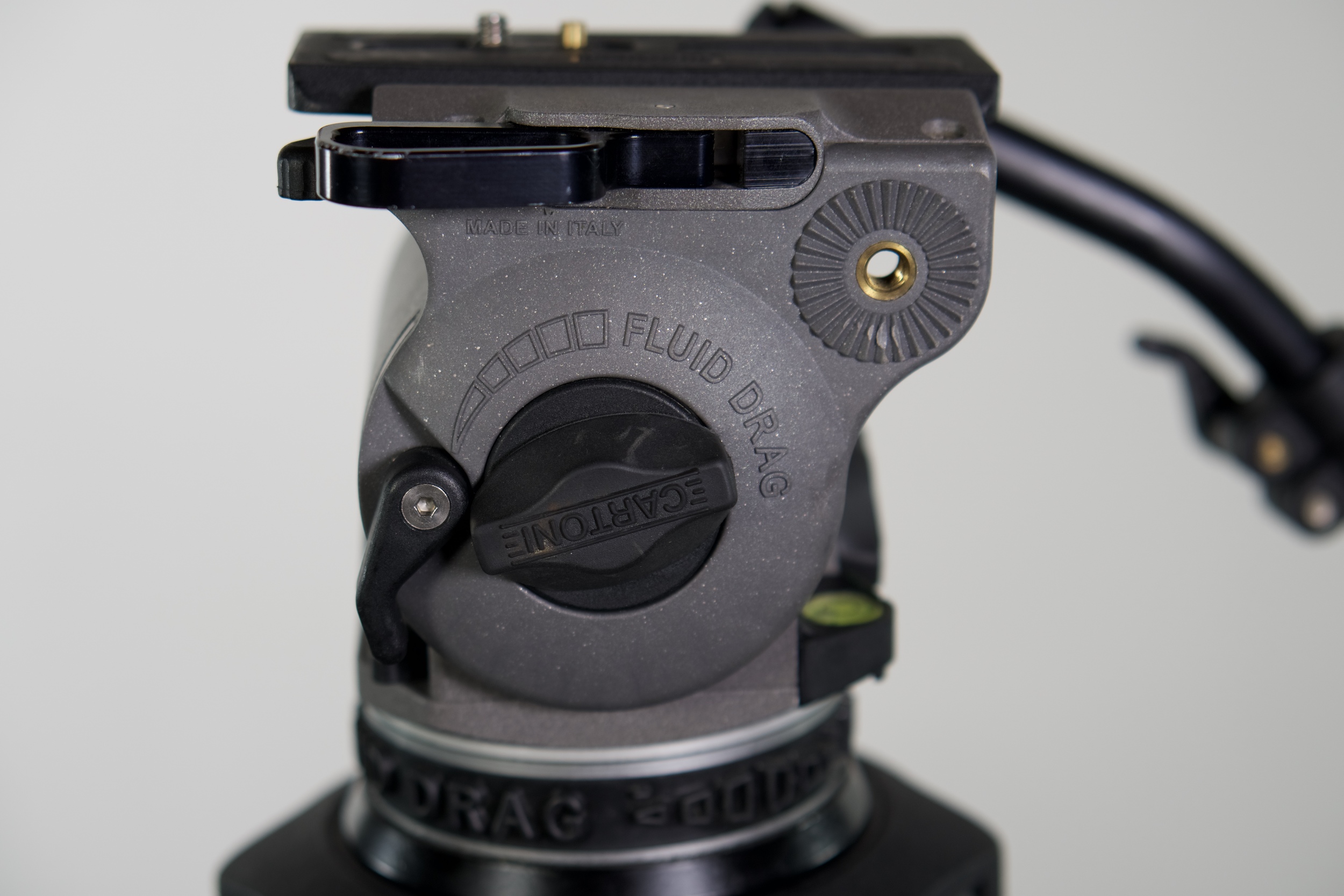At just about $5,000 for a fluid head alone, Sachtler's Video 18 S2 costs more than the cameras owned by most people who read this blog (and just about five times my daily shooter, the Sony a6300). But if you want to know why it costs so much -- or how good it is (spoiler alert: incredible) and when it makes sense -- read on.
Sachtler Video 18 S2 is by far the best -- and most expensive ($5,250)-- fluid head I've ever used. Ditto for the sticks, Sachtler Speed Lock CF ($1,890)
Years ago as I moved from still photography into video with the Canon 5D Mk II, I decided I needed to graduate from a lovely Arca-Swiss ball head mounted on a Gitzo carbon fiber tripod to a real fluid head with appropriate "sticks." I purchased the Cartoni Focus, figuring it would be the first AND last video support system I'd ever need.
Fast forward to late last year, when one of the leg locks on the Cartoni gave way just enough to send a Sony FS7 with an FE PZ 28-135 f/4 lens, Zacuto Gratical HD and Atomos Shogun crashing to the floor.
Some of you have heard this story before.
Ever since, I've wondered what tripod and head I should I have used.
But given my work, the better question is "do I need and can I afford that level of camera along with everything else it requires?"
For me the answer is: "no and no:" My clients and my projects are well-served by a pair of small Sonys (my a6300 and older a6000), for which something like the Cartoni continues to provide a comfortable margin of robustness and precision.
But if I did -- and you may well already be there -- the Video 18 S2 needs to be on your short list of contenders.
On the left, my Cartoni Focus; on the right, the Sachtler Video 18 S2. Both are great for their intended purpose, but the Sachtler aims higher.
The Video 18 S2 is now the third piece of Sachtler kit I've reviewed, and like the Ace Baseplate and Matte Box, it adheres to what I now consider the Sachtler promise: precise, robust, elegant -- and clearly designed by people who have actually worked with this kind of gear in real life, because the details are superb.
This becomes especially apparent when you compare it to what you have today -- or in my case, what I've also had over the years.
From left to right: Benro A48FD monopod with S2 head (well under $200 for the pair), old Cullman aluminum tripod with integrated mini ball head (closest thing to it still in production is probably the $80 Cullman Nanomax with Ball Head), Gitzo G1128 Mk II Carbon Fiber tripod (closest thing to it in current production is the GT2542 Mountaineer at $869) with Arca-Swiss Monoball Head ($320 at B&H), Sachtler Video 18 S2 atop Sachtler Speed Lock CF (100) legs, (set for $8,010 at B&H). I use the Gitzo/Arca-Swiss and/or Cartoni Focus to shoot most of my reviews or out in the field and the Benro when covering live events. I recently handed down the Cullman -- super light-weight and compact, perfect for iphoneography -- to one of my children.
The Cartoni is a wonderful piece of kit, but the Sachtler is better in almost every way. Let's get into it.
Design & Build Quality
It's only when you compare the Sachtler to an already excellent piece -- the Cartoni -- that those details really shine through, beginning at the beginning: with the quick release camera plate.
The quick release camera plate on the Video 18 S2 is locked into a massive base, surrounded on all four sides.
The Cartoni quick-release plate is locked in from the side in a robust but multi-piece base . It uses a threaded screw and a spring-loaded post to prevent twisting. I've always loved the side release - quick, easy, secure, but en toto the Sachtler design is superior.
The camera plate release lever on the Sachtler requires a little more work than the Cartoni and is a little more awkwardly placed, but the end result justifies the effort.
Once we move beyond the camera plate -- but before we move to the controls -- we see two more instances of Sachtler's attention to real-world details.
The design team knew that tripod screws get lost, so they added three threaded holes at the end of the base into which the camera plate locks and include 3/8", 1/4" and pin replacements
If you have to remove the camera, you lift it out of the sliding and lockable base, thus preserving the exact set up you've slaved to get right. Can't do it with the same precision or repeatability on the Cartoni.
From that point onward, every control is built with the same precision, robustness and repeatability in mind.
The one thing that the Sachtler maybe doesn't do quite as well as the Cartoni is switch on the bubble level light. You have to press the bubble itself -- a good idea -- but you have to press really hard. On the other hand, when it goes off, it just doesn't go off: it dims itself. Looks like someone insisted on a touch of artistry. Lovely.
The lighted bubble level on the Cartoni is easier to see and easier to switch on, but that might be because the Cartoni can tilt a full 90° -- the Sachtler doesn't go quite as far. The pan drag on the Cartoni is the rubber ring just below the bubble level that reads "FLUID" -- it's not as easy to grip nor as precise as the Sachtler.
It's not that the Cartoni is a slouch.
The Cartoni is beautifully built and beautiful to look at.
The drag controls are easy to engage, though the locking levers are smaller than those on the Sachtler -- and less easy to unlock.
The pan locking lever, like the tilt locking lever - is small and therefore requires more force to unlock it. Sachtler levers are larger and better placed.
These differences in design show up in the legs from both manufacturers as well.
Both the Sachtler Speedlock CF and Cartoni feature 100mm bowls, and both have sturdy, quick set legs (Cartoni uses two stage legs, Sachtler three). The Cartoni legs are larger diameter and appear to be very robust aluminum, while the Sachtler legs are made of carbon fibre and narrower. Because the Sachtler uses three stages, it can go both a touch higher and a little lower than the Cartoni.
The Cartoni's leg locking mechanism is a bit different, but I've grown to like it. The lever hinges up/down rather than left/right as in every other lever locking tripod I've ever seen.
The Sachtler locking mechanism is a bit different too, but it still a left/right orientation. I think it's a little easier to pinch your fingers this way, though it hasn't happened yet.
The Sachtler sticks came with the Speed Lock, a very clever, faster and easier way to level and lock the head in place than the traditional style knob ti down on the Cartoni.
There's nothing wrong with the mid-level spreader on the Cartoni. It's lightweight and it works.
But the Sachtler spreader is more robust, more polished, and spreads a bit wider.
The Cartoni feet plant firmly and are micro-adjustable. When you unscrew a foot, a pointed tip is revealed for better purchase in grass dirt, ice, etc.
The Sachtler uses very heavy duty rubber loops on its feet. Pull the loops up, and you can remove the feet immediately to reveal not one but two spikes at the end of each leg. Again: clever, quick, robust.
In either case, these are both great pieces of kit, both very smooth given the right payload, and much better for video than my photography go-to, the Gitzo/Arca-Swiss combo -- even if I still use it today. That's one advantage of making the Sony a6300 my go-to camera!
The Arca-Swiss ball head is a gold standard in still photography, but essentially useless for video, much to my chagrin.
My Gitzo 1128 Mk II Carbon Fiber tripod is gorgeous: small, light, sturdy, elegant - but like the Arca-Swiss ball head, simply not designed with the videographer in mind. Even if not designed for video (no bowl!), I still love it and occasionally mount a Manfrotto 502AH or Benro S2 head to it!
Twist locks are easy enough on the Gitzo, but for video lever clamps are better.
In Practice
Outstanding.
The Video 18 S2 and Speed Lock CF handled a pimped-out Sony FS5 with Zacuto Eye, VCT Universal Base Plate and Tripod Plate, Zamerican Arm; Axis Arm, and riser; Convergent Design Odyssey 7q+ 4K recorder/monitor; Rokinon 85mm f/1.5 geared cine lens; Anton Bauer CINE 150 V-mount battery; and Sachtler Ace Matte Box and Follow Focus without breaking a sweat.
Smooth as glass, finger tip control.
Peace of mind: priceless.
Closing Thoughts
At just over $8,000 for this Sachtler set, many of us will never own it or anything like it. Our cameras are smaller, our jobs are smaller, our ambitions more modest.
Or not.
If you're shooting with hybrid stills/video mirrorless or DSLR cameras -- or even if you are but not making a living shooting wildlife with very heavy lenses -- well, heads-up: this is the kind of gear you're going to want when you move up in order to protect and maximize your investment in camera and glass.
And minimize the amount of time you spend setting up.
If you're already a day-in/day-out pro shooting with relatively heavy, dedicated video/broadcast cameras or long and heavy telephoto lenses, you probably already know this.
The first camera I ever bought was a Canon FT-QL. It was nosebleed high beyond my capabilities. When I bought a PRS electric guitar, it was nosebleed high beyond my capabilities, too. Back then, I thought I'd grow into the gear; I'd even learn from the gear. This actually happened with the Canon and led to a life-long passion for image making. It didn't happen with the PRS, which I recently sold.
I was never going to be as good a player as that guitar is an instrument.
The Sachtler Video 18 S2 with Speed Lock CF tripod are not the kind of gear you grow into. They're the kind of tools you use because you can't afford to futz around, and are priced accordingly.
On the other hand, both are easy to appreciate as a tour de force in purposeful design.
Wow.
If you like what you've read here, please subscribe; visit our YouTube channel and subscribe there too and give us a "like"; and if you're in the market for gear, consider using our affiliate links at B&H and Amazon (once you click on them, any purchase will help out) - they don't cost you anything, but they help me stay caffeinated.



























